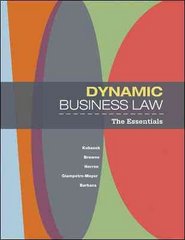Question
1. Consider the following information for a worker named Alex: Alex earns a wage of $15 an hour if he works up to forty hours
1. Consider the following information for a worker named Alex:
- Alex earns a wage of $15 an hour if he works up to forty hours per week. However, for every hour, Alex works in excess of 40 he earns a wage of $30 an hour.
- Alex also faces a 20% tax rate and pays child-care expenses of $4 for every hour he works.
- He also receives child support payments of $80 per week.
- He has a total of 110 hours per week that he can dedicate to work and leisure.
Graph Alex's potential income constraint line:
2. The following information pertains to two individuals:
- They are endowed with T=60 hrs/week of leisure
- They can earn a wage of $7.50 per hour.
- They are only allowed by their employers to work either 40 hrs/week or not at all.
- In a diagram show the equilibrium for:
Worker A: His optimum labour supply is 40 hrs/week
Worker B: Would like prefer to work 20 hours, but still prefers the option of 40hrs/week to not working.
Compare the marginal rates of substitution for both these individuals at 40 hrs/week.
- The average part-time wage is $7 per hour, in contrast to $7.50 per hour for full-time workers. Using the model from part a), provide an explanation for this difference in wage rates.
3. Consider an individual who has to decide how many hours to work in a year. Assume that the maximum number of hours of labour in a year are 4,000 (2 full time jobs), and that this worker can earn $10 an hour.
- Draw the budget constraint facing this individual below:
- Draw an initial indifference curve (above) that represents selecting 2,500 hours of work a year.Labelearnings at this point on the budget constraint.
- The EITC offers an income subsidy to low income workers with children. For a family with two children, this tax credit is 40% for all earnings up to $10,510. The credit reaches its maximum here, at $4,204. Families that earn between $10,510 and $14,730 receive this credit as a lump sum. Families that earn above $14,730 lose 21.06 cents of the credit for each dollar they earn above $14,730. Assuming that this worker has two children, illustrate the impact of this credit in the space provided above.
- Draw an indifference curve for this individual that is tangent to his new budget constraint. How does the EITC affect hours of work? Is this the intended effect of the EITC? Why might this effect not occur in the real world?
- How would the effect on hours of labour differ if the individual initially did not work? Why?
4. Suppose there two workers with identical preferences - Joanne and Anna.
- Joanne and Anna have the same life cycle wage path in terms of the waged faced every age. Further, they both know what their future wages will be.
- Leisure and consumption are both normal goods.
- In a diagram, relate the life cycle path of hours of work between these two workers if Anna receives a one-time,unexpected inheritancewhen she turns 35 years old.
- In a diagram, relate the life cycle path of hours of work between the two workers if Anna had always known he would receive (and, in fact, does receive) a one-time inheritance at the age of 35.
5.Consider the following information regarding a hypothetical manufacturing firm: Its production is contingent on two normal inputs: labour and capital Their prices are denoted aswandr, respectively.
Initially the firm faces market prices ofw= $6 andr= $4. Subsequently, these prices then change tow= 4 andr= 2.
- In which direction will the substitution effect change the firm's employment and capital stock?
- In which direction will the scale effect change the firm's employment and capital stock?
- Can we say conclusively whether the firm will use more or less labour? More or less capital?
6. Consider the following information regarding a manufacturing firm:
- There are two inputs to production: labour and capital
- However, these inputs areperfect substitutesin production.
- The firm's existing technology allows one machine to do the work of three workers.
- The firm is interested in producing 100 units of output.
- Suppose the price of capital is $750 per machine per week.
- What combination of inputs will the firm use if the weekly salary of each worker is $300?
- What combination of inputs will the firm use if the weekly salary of each worker is $225?
- What is the elasticity of labour demand as the wage falls from $300 to $225?
Step by Step Solution
There are 3 Steps involved in it
Step: 1

Get Instant Access to Expert-Tailored Solutions
See step-by-step solutions with expert insights and AI powered tools for academic success
Step: 2

Step: 3

Ace Your Homework with AI
Get the answers you need in no time with our AI-driven, step-by-step assistance
Get Started


